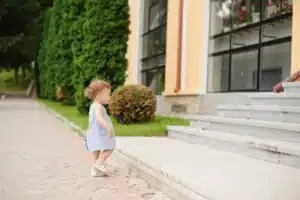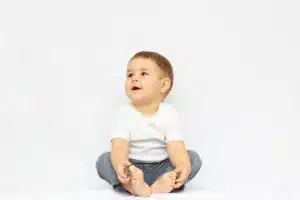By Nicole Crisan PT, DPT
Jumping is a higher-level gross motor skill that typically develops between 2-3 years old. It takes strength, balance, coordination, and motor control to jump with two feet. This article will help break down the different phases of jumping as well as different activities that you can incorporate during play with your child to work on jumping.
Phases of Jumping:
- Preparation Phase: Lowering into a squat position
- Propulsion Phase: Pushing through the legs in attempts to lift both feet off the ground
- Flight Phase: Both feet are off the ground
- Landing Phases: Feet return to the ground
When first learning to jump, your child may have difficulties with one or multiple phases.
Below are various activities that you can work on with your child to help them at each phase.
Preparation Phase:
Start introducing what jumping is! You can model jumping by jumping in place and see if your child will mimic your actions. When you start to lower yourself down into a squat verbally say “down” or “bend” as you enter the preparation phase. Then, as you lift your feet off the floor say “Jump!” This way your child can start to understand what a jump is.
Propulsion Phase:
In this phase we focus on the strength and coordination of their hip and calf muscles, crucial for generating the power needed to propel themselves off the ground.
- Heel Raises: Placing suction toys, stickers, and/or other objects that stick on a window or wall to encourage your child to rise on their toes, improving on their calf strength
- Squats: Placing toys/objects between their feet when they pick them up to work on strengthening their hips and calf muscles
- Playing in a deep squat: Instead of sitting on the floor, have them maintain a squat position while they are playing!
- Ex: popping bubbles, building block towers, completing a puzzle, playing with Play-Doh
- Combine activities: To work on coordinating the preparation and propulsion phases, have your child squat down and then rise on their toes.
- Ex: Placing stickers on the floor and a piece of paper on the wall. Have your child squat down to get a sticker and then rise on their toes to place the sticker on the paper. Popping bubbles-placing the bubbles high encouraging them to reach up and then placing them down low encouraging them to squat
Flight Phase:
Your child might have an understanding of what jumping is but still need some help to lift their feet off the ground.
- Bouncing: On the sofa/bed (with supervision!) Singing or playing songs like “5 Little Monkeys” or “Hop Little Bunny” to encourage your child to bounce in place while holding onto a stable surface (sofa or your hands) while they are jumping on the bed or sofa. The additional support they get by holding onto something can allow them to be able to start lifting their feet off the ground. The bed/sofa often has springs/is bouncier which also provides some momentum to lift their feet up as they are learning to jump
- Trampoline: There are child-sized trampolines that come with handrails that your child can hold onto as they bounce in place. (This is like jumping on the sofa/bed)
- Providing support: Hold your child’s hands and ask them to jump. If you do not feel them putting any resistance in your hands as they try to jump, hold them closer to their body, such as under or close to their shoulders. Then, you can help lift them up as you see and feel them attempt to push through their legs. As your child starts to get stronger and they are giving you resistance in the arms, then you can start helping them jump.
- Jumping down from a small step/curb: holding their hands and as they start to push up help them move forward to jump down.
- Jumping forward: Place tape or draw a line on the floor and help them jump over it
- Visual cues: Draw shapes or use mats/paper of different colors to provide visual cues to learn to jump forward. Start with small distances-object 1-2in apart and then gradually increase the distance as they get better at jumping
Landing Phase:
Sometimes, when your child is first learning to jump, they land and keep their legs straight. Work on having them bend their knees slightly to use their muscles to soften their landing and prevent additional stress to their knee joints
- Landing on soft surfaces: When jumping, have your child land on softer surfaces (pillows, couch cushions) as this will force them to start to bend their knees when they land to keep their balance
- Demonstrations: Model landing while you bend your knees and have your child copy you
Additional Activities:
- Set up obstacle courses or play “The Floor is Lava” where they can jump over small objects, down boxes, or jump in and out of shapes drawn on the floor.
- Have a dance party! Play songs and model jumping
- Jump in different environments: On the trampoline, off a bottom step, forward, and on different surfaces. Provide your child with assistance as needed.
- Make it part of your day: Find at least one time in your day that you can practice jumping with your child and try to incorporate it into their routine. Like jumping down from the last step, jumping over cracks in the sidewalk, jumping on or over patterns on a carpet. This will make jumping fun and allow them to practice the skill daily!
Conclusion
Jumping combines many different muscle groups and helps your child build strength, coordination, balance, and motor control. It is also a fun activity that they can engage in with their peers, family members, and other caregivers. Jumping can unlock many other creative endeavors whether it is jumping in puddles or dancing to their favorite tunes.




